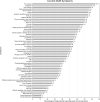Targeting earlier diagnosis: What symptoms come first in Degenerative Cervical Myelopathy?
- PMID: 37000805
- PMCID: PMC10065274
- DOI: 10.1371/journal.pone.0281856
Targeting earlier diagnosis: What symptoms come first in Degenerative Cervical Myelopathy?
Abstract
Background: Degenerative cervical myelopathy (DCM) is a common and disabling condition. Early effective treatment is limited by late diagnosis. Conventional descriptions of DCM focus on motor and sensory limb disability, however, recent work suggests the true impact is much broader. This study aimed to characterise the symptomatic presentation of DCM from the perspective of people with DCM and determine whether any of the reported symptoms, or groups of symptoms, were associated with early diagnosis.
Methods: An internet survey was developed, using an established list of patient-reported effects. Participants (N = 171) were recruited from an online community of people with DCM. Respondents selected their current symptoms and primary presenting symptom. The relationship of symptoms and their relationship to time to diagnosis were explored. This included symptoms not commonly measured today, termed 'non-conventional' symptoms.
Results: All listed symptoms were experienced by >10% of respondents, with poor balance being the most commonly reported (84.2%). Non-conventional symptoms accounted for 39.7% of symptomatic burden. 55.4% of the symptoms were reported as an initial symptom, with neck pain the most common (13.5%). Non-conventional symptoms accounted for 11.1% of initial symptoms. 79.5% of the respondents were diagnosed late (>6 months). Heavy legs was the only initial symptom associated with early diagnosis.
Conclusions: A comprehensive description of the self-reported effects of DCM has been established, including the prevalence of symptoms at disease presentation. The experience of DCM is broader than suggested by conventional descriptions and further exploration of non-conventional symptoms may support earlier diagnosis.
Copyright: © 2023 Munro et al. This is an open access article distributed under the terms of the Creative Commons Attribution License, which permits unrestricted use, distribution, and reproduction in any medium, provided the original author and source are credited.
Conflict of interest statement
I have read the journal’s policy and the authors of this manuscript have the following competing interests: CFM has declared that no competing interests exist. RY has declared that no competing interests exist. ZCM has declared that no competing interests exist. MGF currently serves as an academic editor at PLOS ONE. RRP has declared that no competing interests exist. JM has declared that no competing interests exist. KM has declared that no competing interests exist. MRNK has declared that no competing interests exist. BMD is supported by NIHR POLYFIX DCM and NIHR Clinical Doctoral Research Fellowship grants. BMD is a founder of MoveMed (a digital therapeutics platform which develops assessments and treatments using software). The funders had no role in study design, data collection and analysis, decision to publish, or preparation of the manuscript. This does not alter our adherence to PLOS ONE policies on sharing data and materials.
Figures







References
-
- Fehlings MG, Wilson JR, Kopjar B, Yoon ST, Arnold PM, Massicotte EM, et al. Efficacy and safety of surgical decompression in patients with cervical spondylotic myelopathy: results of the AOSpine North America prospective multi-center study. J Bone Joint Surg Am. 2013. Sep 18;95(18):1651–8. doi: 10.2106/JBJS.L.00589 - DOI - PubMed
-
- Fehlings MG, Ibrahim A, Tetreault L, Albanese V, Alvarado M, Arnold P, et al. A global perspective on the outcomes of surgical decompression in patients with cervical spondylotic myelopathy: results from the prospective multicenter AOSpine international study on 479 patients. Spine. 2015. Sep 1;40(17):1322–8. doi: 10.1097/BRS.0000000000000988 - DOI - PubMed
-
- Tetreault LA, Karpova A, Fehlings MG. Predictors of outcome in patients with degenerative cervical spondylotic myelopathy undergoing surgical treatment: results of a systematic review. Eur Spine J Off Publ Eur Spine Soc Eur Spinal Deform Soc Eur Sect Cerv Spine Res Soc. 2015. Apr;24 Suppl 2:236–51. doi: 10.1007/s00586-013-2658-z - DOI - PubMed
-
- Tetreault L, Wilson JR, Kotter MRN, Côté P, Nouri A, Kopjar B, et al. Is Preoperative Duration of Symptoms a Significant Predictor of Functional Outcomes in Patients Undergoing Surgery for the Treatment of Degenerative Cervical Myelopathy? Neurosurgery. 2018. Nov 16; - PubMed
Publication types
MeSH terms
LinkOut - more resources
Full Text Sources
Medical

